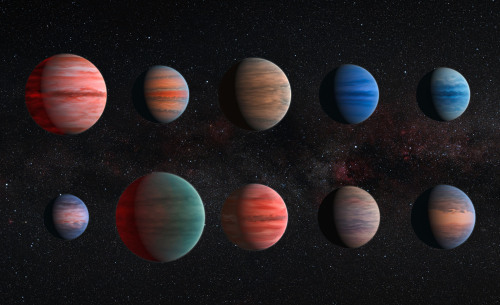Insight A - Fifth Planet (Insight A-V)





Pictures of the day - December 20, 2018
Insight A - Fifth Planet (Insight A-V)
Insight A-V is a hot earth-like planet with oceans. The planet does support marine life, but the surface is far too inhospitable for anything other than Extremophiles. The planet is much smaller and less massive than Earth at 0.14 Earth masses and a diameter roughly half that of Earth. The surface is very active with a hot atmosphere. The surface averages 161 F, with an atmosphere only 54% as thick of Earth’s that is dominated by carbon dioxide. The surface is so hot that there are no ice caps or even snow on mountain-tops.
The planet rotates backwards with an axial tilt of 148 degrees and a rotational rate of 24 hours and 21 minutes. No moons orbit the planet.
High Resolution Pictures
Insight A-V
Earth-Like World
Cyclone
The Surface
Polar orbit
More Posts from Sharkspaceengine and Others

Picture of the day 2 - December 21, 2018
Dwarf planet it’s moon. Part of the Insight A System.
Green Desert

Picture of the Day - November 2, 2018
Weird green desert-world rich in life, but lacking any bodies of surface liquids. Planet has a thin carbon dioxide atmosphere, average surface temperature of 73°F on the day side and is tidally locked to the sun.

Picture of the day - January 9, 2019
Ringed Desert-Like moon with life and a large moon.
River Valley

Picture of the day - October 30, 2018
Best shot yet of a river valley I have found, taken on an Earth-like world. The planet has a unique yellow-colored atmosphere.
Not space related, but wanted to see what my space engine followers thought of this question. Hoping to get some good memes out of it.
Shark Question
Are male sharks now going to be banned if their claspers are visible? Also are female sharks with scars on their face going to be banned since that can be considered sexual abuse by a male shark?


Pictures of the Day - February 12, 2019 (Late Post)
Stormy atmosphere of a gas giant. The planet orbits a binary pair of stars consisting of a white F-Type star and a bright blue B-type star

Picture of the day 3 - November 19, 2018
Dim red sun faintly illuminates a giant planet and it’s ring in a dull red light.
Another Moon Shot

Picture of the day - October 26, 2018
A large moon against the backdrop of a stunningly colorful gas giant and it’s rings.
Hot Jupiter
Planets in our own solar system have a wide range of properties. They are distinguished by two basic properties, their size and their orbit. The size determines if the planet can have a life-sustaining atmosphere. The orbit affects the surface temperature and whether there could be liquid water on the planet’s surface.

Hot Jupiters are a class of gas giant exoplanets that are inferred to be physically similar to Jupiter but that have very short orbital period (P<10 days). The close proximity to their stars and high surface-atmosphere temperatures resulted in the moniker “hot Jupiters”.

Hot Jupiters are the easiest extrasolar planets to detect via the radial-velocity method, because the oscillations they induce in their parent stars’ motion are relatively large and rapid compared to those of other known types of planets.

One of the best-known hot Jupiters is 51 Pegasi b. Discovered in 1995, it was the first extrasolar planet found orbiting a Sun-like star. 51 Pegasi b has an orbital period of about 4 days.

There are two general schools of thought regarding the origin of hot Jupiters: formation at a distance followed by inward migration and in-situ formation at the distances at which they’re currently observed. The prevalent view is migration.

Migration
In the migration hypothesis, a hot Jupiter forms beyond the frost line, from rock, ice, and gases via the core accretion method of planetary formation. The planet then migrates inwards to the star where it eventually forms a stable orbit. The planet may have migrated inwar.
In situ
Instead of being gas giants that migrated inward, in an alternate hypothesis the cores of the hot Jupiters began as more common super-Earths which accreted their gas envelopes at their current locations, becoming gas giants in situ. The super-Earths providing the cores in this hypothesis could have formed either in situ or at greater distances and have undergone migration before acquiring their gas envelopes.

source
-
 evenglitterfadestodust liked this · 6 years ago
evenglitterfadestodust liked this · 6 years ago -
 brushesnbunnies liked this · 6 years ago
brushesnbunnies liked this · 6 years ago -
 israel1003-blog liked this · 6 years ago
israel1003-blog liked this · 6 years ago -
 harmonicgamingangel22blog reblogged this · 6 years ago
harmonicgamingangel22blog reblogged this · 6 years ago -
 harmonicgamingangel22blog liked this · 6 years ago
harmonicgamingangel22blog liked this · 6 years ago -
 sharkspaceengine reblogged this · 6 years ago
sharkspaceengine reblogged this · 6 years ago
My Space Engine Adventures, also any space related topic or news. www.spaceengine.org to download space engine. The game is free by the way. Please feel free to ask me anything, provide suggestions on systems to visit or post any space related topic.Check out my other blog https://bunsandsharks.tumblr.com for rabbit and shark blog.
294 posts
